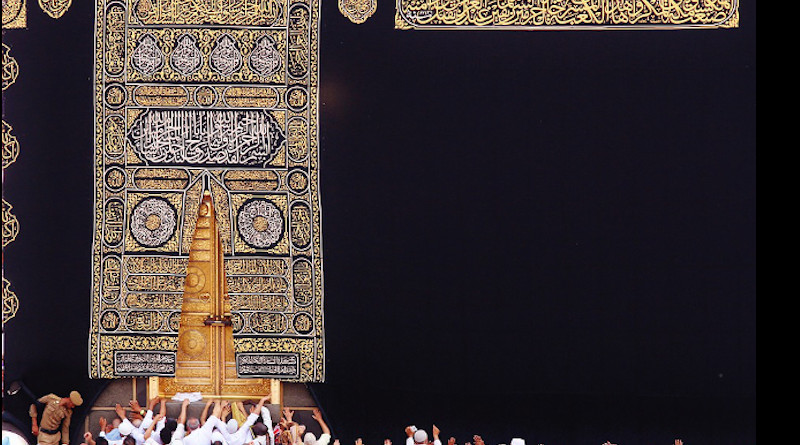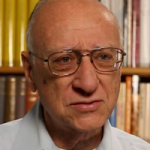The Jerusalem Temple And Its Older Brother: The Ka’ba – OpEd

Narrated Abu Dhar: I said, “O Allah’s Messenger, which mosque was first built on the surface of the earth?” He said, “Al- Masjid-ul-,Haram (in Mecca).”
I said, “Which was built next?” He replied “The mosque of Al-Aqsa ( in Jerusalem) .” I said, “What was the period of construction between the two?” He said, “Forty years.” (Sahih al-Bukhari 3366 In-book reference : Book 60, Hadith 45 USC-MSA web (English) reference : Vol. 4, Book 55, Hadith 585)
The Jerusalem Temple (Beit HaMikdosh) and the Ka’ba, the House of God (Baitullah) in Mecca are the two most well-known sites for monotheistic pilgrimage in the world.
The Islamic Hajj to the Ka’ba in Makkah, and the Jewish Hajj to the Temple in Jerusalem, have been alternate swings of a single sacred pendulum connecting earthly humans to one monotheistic Divine source in the heavens.
The Ka’ba was the original site of the Islamic Hajj. Destroyed in the days of Noah, it was later rebuilt by Abraham and his son Ishmael. After several centuries it was desecrated by later generations of idol worshipers.
During the centuries while the Ka’ba was desecrated, Prophet Solomon built a Temple in Jerusalem for Jewish Haj on the site where Abraham bound his son Isaac as an offering to God.
Four centuries later the Temple of Solomon was destroyed in 587 BCE by the Babylonians. Then the Temple was rebuilt with the support of Cyrus the Great, King of Persia, and lasted for almost six centuries. As Philo of Alexandria (c. 20 BCE – c. 50 CE) states; Jewish pilgrims came to Jerusalem from the ends of the earth, and from all the compass points.
But with the destruction of the Second Temple by the Romans in 70 CE, the pilgrimage Hajj aspect of the week-long harvest festival of Hag Sukkot, began a gradual decline in the spiritual consciousness of the Jewish People.
The first time Hag/Hajj is mentioned in the Torah is in that famous scene when Prophets: “Moses and Aaron told Pharaoh; ‘Thus says the LORD God of Israel, Let my people go into the wilderness, that they may hold a feast (Hag) for me.'” [Exodus 5:1]or better: “And afterward Moses and Aaron went in and told Pharaoh; ‘Thus says the LORD God of Israel, Let my people go, that they may hold a Hajj/pilgrimage feast for me in the wilderness.'”
But that one-time Hajj never occurred because Pharaoh refused to free the Jewish People thus incurring Divine wrath.
The normative annual two Jewish Hajj week-long pilgrimages was the liberation celebration of Haj Passover; and especially the gratitude celebration of the harvest festival of Haj Sukkot. The Torah declares: “Celebrate Hajj Sukkot for seven days after you have harvested the produce of your threshing floor and your winepress. Be joyful at your festival—you, your sons and daughters, your male and female servants, the Levites, the foreigners, the fatherless and the widows who live in your towns…Three times a year all your men must appear before the Lord your God at the place He will choose: at the Hajj of Matzah (Passover), the Hajj of Weeks, and the Hajj of Sukkot. (Deuteronomy 16:13-16)
Hajj Sukkot was so important during the centuries when Solomon’s Temple stood that the holy week of Sukkot was often called simply “the Hajj” because of the very large numbers of Jews who came up to the Temple in Jerusalem. Hajj Passover is also celebrated as a weeklong pilgrimage.
The third Hajj of Weeks is similar to Islamic Umrah, the non-mandatory lesser pilgrimage made by Muslims to Mecca, which may be performed at any time of the year. Although they share common rites, Umrah can be performed in less than a few hours; while Hajj is more time-consuming and involves many more rituals.
The third Jewish Hajj of Weeks, like Umrah, is much simpler than Hajj Passover and can be performed in less than a few hours; on any one day during the seven weeks following Hajj Passover.
The Sacred Mosque (Masjid al-Haram) is the largest mosque in the world and it surrounds one of Islam’s holiest places, the Ka-ba. Unlike other mosques which are gender segregated, men and women can worship at the Al-Masjid Al-Haram together.
The Holy Temple (Beit ha-Mikdash) of Jerusalem had two successive Temples on the Temple Mount where there now stands the Dome of the Rock. The Jerusalem Temple complex was separated into different areas where male priests, men, women and non-Jews could all come to worship the one God.
Why is the Ka’ba the older brother of the Jerusalem Temple? Prophet Abraham is connected to both sacred sites. Prophets Abraham and Ishmael rebuilt the destroyed Ka’ba; and 40 years later, Prophets Abraham and Isaac were tested on the hill where the Jerusalem Temple would someday be built by Prophet Solomon.
Since Islam is the last of the Abrahamic religions it is the most universal of them. Since Judaism is the first, and for over twelve centuries the only ongoing monotheistic religion, it is the least universal and the most pluralistic and tribal of the three Abrahamic religions.
For thousands of years before Prophet Abraham, Allah sent thousands of prophets to thousands of tribes and nations on the earth, and not one of them were able to establish an ongoing imageless monotheistic community. So Allah decided to do things in a different way.
Allah decided to make a covenant with a small tribe, and send six hundred of his prophets to this small tribe, and worked continually for more than a dozen centuries with the people of this tribe until they were able to establish an ongoing community that would always have a core of righteous and loyal believers.
Prophet Abraham, the Hebrew (Genesis 14:13) was the first, and only prophet, to successfully establish, through the descendants of his own two sons, three ongoing monotheistic religions, that have lasted into the 21st century: Judaism, Christianity, and Islam; that now make up about half of the world’s population.
Judaism discourages people who are interested in converting to Judaism because Judaism is the only true religion. Indeed, most non-Jews who become Jewish do it to unify a marriage or because they have a Jewish ancestor even if they do not yet know it.
Judaism is not a missionary faith and so doesn’t actively try to convert non-Jewish people (in many countries anti-Jewish laws prohibited converting to Judaism for centuries). However, the modern Jewish community increasingly welcomes would-be converts. A person who converts to Judaism becomes a Jew and is just as Jewish as someone born into Judaism.
As Prophet Micah (4:5) states: “For all the (other) peoples walk each in the name of its god; and we (Jews) will walk in the name of the LORD our God forever and ever.”
Five hundred years before the birth of Prophet Muhammad Rabbi Yishmael, one of Judaism’s most important rabbis was recorded as saying: “In the future, the sons of Ishmael (the Arabs) will do fifteen things in the Land of Israel … They will fence in the breaches of the walls of the Temple, and construct a building (the Dome of the Rock) on the site of the (ruined by the Romans) sanctuary”.
Prophet Zechariah even includes those who were previously Israel’s enemies: “Then the survivors from all the nations that have attacked Jerusalem, will go up year after year to worship the King, the Lord Almighty, and to celebrate Hajj Sukkot.” (Zechariah 14:16)
There is vacant land on the Temple Mount, and a three dimensional virtual reality broadcast station could be erected adjacent to the Dome of the Rock fulfilling the vision of Prophet Micah (4:1-3) “In the end of days the mountain of the Lord’s Temple will be established as the highest mountain; it will be exalted above the hills, and (monotheistic) peoples will stream to it. Many (not all) nations will come and say, ‘Come, let us go up to the mountain of the Lord, to the Temple of the God of Jacob. who will teach us his ways, so that we may walk in his paths. Torah will be broadcast out from Zion, and the word of the Lord from Jerusalem.” provided that Muslim leaders would cooperate.
Just as the Ka’ba has always welcomed all Muslims who answer the call: “Call upon the people for Hajj. They will come to you on their bare feet, or riding any weak camel, and they come to you from every far desert. (Qur’an 22:27).
When all those, both near and far, who revere this place as a standard, share it in love with everyone else who reveres it, then I will do as Prophet Abraham requested, and “Make this a land of Peace, and provide its people with the produce of the land”. (Qur’an 2:126). Then will all the children of Prophet Abraham live in Holiness, Peace and Prosperity.
The Qur’an refers to Prophet Abraham as a community or a nation: “Abraham was a nation-community [Ummah]; dutiful to God, a monotheist [hanif], not one of the polytheists.” (16:120)
If Prophet Abraham is an Ummah then fighting between the descendants of Prophets Ishmael and Isaac is a civil war and should always be avoided.
If all Arabs and Jews can live up to the ideal that ‘the descendants of Abraham’s sons should never make war against each other’ is the will of God; we will help fulfill the 2700 year old vision of Prophet Isaiah: “In that day there will be a highway from Egypt to Assyria. The Assyrians will go to Egypt, and the Egyptians to Assyria. The Egyptians and Assyrians will worship together.
“On that day Israel will join a three-party alliance with Egypt and Assyria, a blessing upon the heart. The LORD of Hosts will bless them saying, “Blessed be Egypt My people, Assyria My handiwork, and Israel My inheritance.”…(Isaiah 19:23-5)

Rabbi Allen S. Maller
Allen Maller retired in 2006 after 39 years as Rabbi of Temple Akiba in Culver City, Calif. He is the author of an introduction to Jewish mysticism. God. Sex and Kabbalah and editor of the Tikun series of High Holy Day prayerbooks.
No comments:
Post a Comment